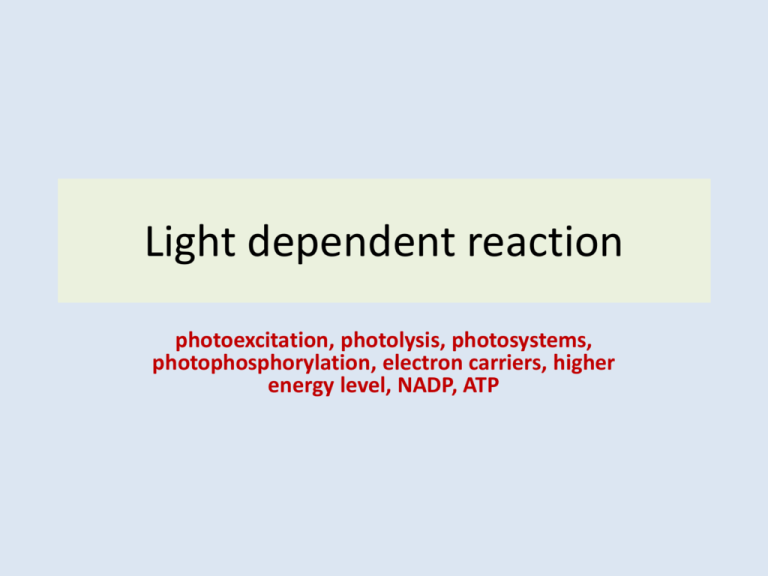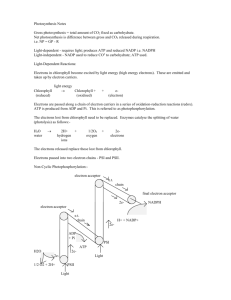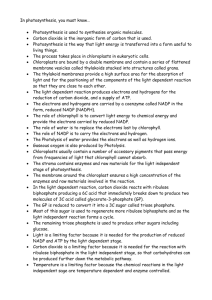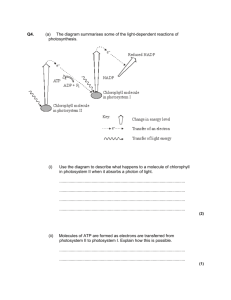Light independent reaction
advertisement

Light dependent reaction photoexcitation, photolysis, photosystems, photophosphorylation, electron carriers, higher energy level, NADP, ATP Learning outcomes • Be able to explain how photolysis of water produces protons, electrons and oxygen. C • Be able to explain how light energy excites electrons in chlorophyll B • Be able to explain how energy from these excited electrons generates ATP and reduced NADP for the independent reaction B • Be able to explain how the production of ATP involves electron transfer associated with the electron transfer chain in chloroplast membranes and movement of H ions B/A Pigments and photosystems • Chloroplasts contain photosynthetic pigments to absorb the light energy • Pigments are chlorophyll a, chlorophyll b and carotene • The pigments are found in the thylakoid membranes attached to proteins. • The protein and pigment are called a photosystem • Two photosystems used by plants to absorb light are PSI ( 700nm wavelength) and PSII ( 680nm wavelength) Photosynthesis • Photosynthesis can be split into two stages • The light-dependent reaction • The light-independent reaction – AKA the Calvin Cycle Photosynthesis Light dependent reaction • This reaction needs light energy • Takes place in the thylakoid membranes • Light energy absorbed by photosynthetic pigments in the photosystems and converted to chemical energy • Light energy is used to add inorganic phosphate to ADP to form ATP • And reduce NADP to form reduced NADP • ATP transfers energy and reduced NADP transfers hydrogen to the light independent reaction • During the process H2O is oxidised to O2 Analogy Light dependent reaction • http://highered.mcgrawhill.com/olcweb/cgi/pluginpop.cgi?it=swf::535 ::535::/sites/dl/free/0072437316/120072/bio 13.swf::Photosynthetic%20Electron%20Transp ort%20and%20ATP%20Synthesis Light dependent reaction Photophosphorylation and photolysis • In the light-dependent reaction, the light energy absorbed by the photosystems is used for three things: • Making ATP from ADP and Pi – this is known as photophosphorylation • Making reduced NADP from NADP • Splitting water into protons( H+ ions), electrons and oxygen. This is called photolysis Things to do Using the information from • The animation • From the diagram • From textbooks Produce a summary piece that will enable you to remember the sequence of events, the new vocabulary and the end products of the light dependent reaction photoexcitation, photolysis, photosystems, photophosphorylation, electron carriers, higher energy level, NADP, ATP • http://highered.mheducation.com/olcweb/cgi /pluginpop.cgi?it=swf::535::535::/sites/dl/free /0072437316/120072/bio12.swf::Cyclic and Noncyclic Photophosphorylation • What is the difference between cyclic noncyclic photophosphylation? Light-dependent reaction 1 Non-cyclic photophosphorylation • Produces ATP, reduced NADP and O2 • Photosystems in the thylakoid membranes are linked by electron carriers • Electron carriers are proteins that transfer electrons • The photosystems and their electron carriers form an electron transport chain – a chain of proteins through which excited electrons flow Light energy excites electrons in chlorophyll • Light energy is absorbed by PSII • Light energy excites electrons in chlorophyll • The electrons move to a higher energy level • These high energy electrons move along the electron transport chain to PSI Photolysis of water produces protons ( H+ ions), electrons and O2 • As the excited electrons from chlorophyll leave PSII to move along the electron transport chain, they must be replaced • Light energy splits water into protons (H+ ions), electrons and oxygen • H2O 2H+ + 1/2 O2 Energy from the excited electrons makes ATP • The excited electrons lose energy as they move along the electron transport chain • This energy is used to transport protons into the thylakoid so that the thylakoid has a higher concentration of protons than the stroma. This forms a proton gradient across the membrane • Protons move down their concentration gradient, into the stroma, via an enzyme ATP synthase. The energy from this movement combines ADP and Pi to form ATP • Chemiosmosis is the name of the process where the movement of H+ ions across a membrane generates ATP – this also occurs in respiration Generation of reduced NADP • Light energy is absorbed by PSI, which excites the electrons again to an even higher energy level • Finally, the electrons are transferred to NADP, along with a proton (H+ ion) from the stroma, to form reduced NADP Cyclic photophosphorylation • Only uses PSI • Cyclic because the electrons used aren’t passed to NADP, but passed back to PSI via electron carriers • Electrons recycled and used repeatedly to flow through PSI • Produces small amounts of ATP Things to do Using the information from • The animation • From the diagram • From textbooks Produce a summary piece that will enable you to remember the sequence of events, the new vocabulary and the end products of the light dependent reaction photoexcitation, photolysis, photosystems, photophosphorylation, electron carriers, higher energy level, NADP, ATP The best ones will include for vocab.. Photoexcitation – what is it (B) Photolysis – what happens and why (C) Photosystems – what are these, which comes first and why do they have those numbers (B) Photophosphorylation – your exam board loves this. What does it mean? (C/B) Be able to explain how photolysis of water produces protons, electrons and oxygen. C Be able to explain how light energy excites electrons in chlorophyll B Be able to explain how energy from these excited electrons generates ATP and reduced NADP for the independent reaction B Be able to explain how the production of ATP involves electron transfer associated with the electron transfer chain in chloroplast membranes and movement of H ions B/A The best ones will include for explanation.. Be able to explain how Electron carriers – what are these, what are their names and why role do they play? (B) What is the fundamental purpose of the light dependent reaction? (B) Where precisely does it take place? (B/A) What role do the H ions play? (A) photolysis of water produces protons, electrons and oxygen. C Be able to explain how light energy excites electrons in chlorophyll B Be able to explain how energy from these excited electrons generates ATP and reduced NADP for the independent reaction B Be able to explain how the production of ATP involves electron transfer associated with the electron transfer chain in chloroplast membranes and movement of H ions B/A Plenary • Test your understanding of the light dependent reaction and the products with some exam questions • Mark your own and award yourself a grade based on the learning outcomes • Make a note of what you need to do to improve your grade • Write an equation(s) for photosynthesis that better reflects the process of the light dependent reaction.





